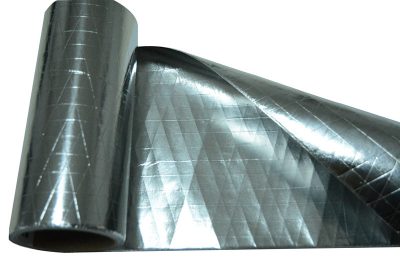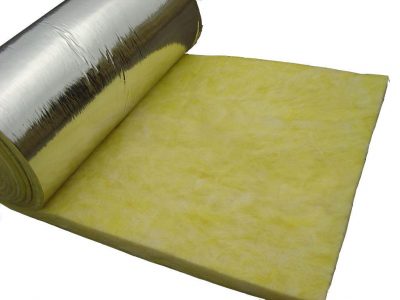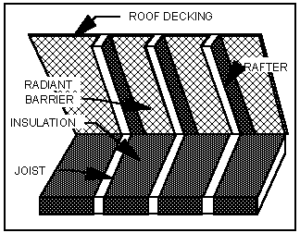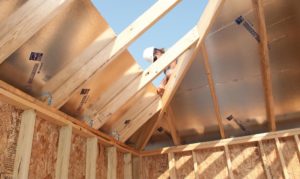The best application for a radiant barrier is in hot climates just under the roof. Radiant barriers are most effective in blocking summer radiant heat gain and saving air-conditioning costs. Although the radiant barrier may be somewhat effective in retaining heat within a cold-climate home, it may also block winter radiant heat gain in the attic.(www.myfloridahomeenergy.com)
The Radiant barriers consist of a highly reflective material that reflects radiant heat rather than absorbing it. Radiant heat travels in a straight line away from any surface and heats anything solid that absorbs its energy. Radiant barriers don’t, however, reduce heat conduction like thermal insulation materials. Radiant barriers and reflective insulation work by reducing radiant heat gain. When the sun heats a roof, it’s primarily the sun’s radiant energy that makes the roof hot. Much of this heat travels by conduction through the roofing materials to the attic side of the roof. The hot roof material then radiates its gained heat energy onto the cooler attic surfaces, including the air ducts and the attic floor. A radiant barrier reduces the radiant heat transfer from the underside of the roof to the other surfaces in the attic. To be effective, the reflective surface must face an air space.(www.energy.gov/energysaver/radiant-barriers)
Comparison of the Roof with and without Radiant Barrier

Properties to look for in a radiant barrier are high reflectivity and very low emittance (the energy radiated from the material’s surface), which enable it to reflect the radiant heat energy and give off (emit) very little.
Types of Radiant Barriers
Radiant barriers consist of a highly reflective material, usually aluminum foil, which is applied to one or both sides of a number of substrate materials such as kraft paper, plastic films, cardboard, oriented strand board, and air infiltration barrier material. Some products are fiber-reinforced to increase durability and ease of handling. (www.yourhome.gov.au/passive-design/insulation, www.myfloridahomeenergy.com)
Reflective insulation
Radiant barriers can be combined with many types of insulating materials in reflective insulation systems. In these combinations, radiant barriers can act as the thermal insulation’s facing material. Reflective insulation is usually shiny aluminum foil laminated onto paper or plastic and is available as sheets (sarking), concertina-type batts and multi-cell batts. Together these products are known as reflective foil laminates or RFL.
Reflective insulation mainly resists radiant heat flow due to its high reflectivity and low emissivity (ability to re-radiate heat). It relies on the presence of an air layer of at least 25mm next to the shiny surface. The thermal resistance of reflective insulation varies with the direction of heat flow through it. The total R-values for reflective insulation are supplied as ‘up’ and ‘down’ values. Total values depend on where and how the reflective insulation is installed. (www.yourhome.gov.au/passive-design/insulation)
Common Types of Reflective Insulation

RFL Sarking Installation and Double Side Reflective Aluminium Foil
Multi-cell Foil Batts and Concertina-type Foil Batts
Composite bulk
Composite bulk (bulk insulation resists the transfer of conducted and convected heat, relying on pockets of trapped air within its structure) and reflective materials are available that combine some features of both types. Examples include reflective foil faced blankets, foil backed batts and foil faced boards. (www.yourhome.gov.au/passive-design/insulation)
Foil-faced Fiberglass Roof Blanket and Foil-backed Fiberglass Batt
Movable Radiant Barrier to Prevent Heat-gain of the Roof Slab
From sunrise to sunset, this flexible cover, with a very shiny bottom, is drawn over the slab. It shades the slab, while its low emissivity (0.01) due to the shiny surface prevents any radiant heating of the slab. The slab gains some heat from the ambient air yet remains below 30°C. Occupants in spaces under the slab feel cool and a ceiling fan would throw cool air. During the night, the slab remains open to the sky. This allows radiant heat transfer from the slab surface (~30°C) to the sky (~ -40 to -60°C, depending on haze and clouds). The rate depends on the temperature difference of fourth powers and the emissivity of the slab (0.85). Slab bottom cools down to 27°C. (Fairconditioning, BEMAP, Sustainable cooling technics)
Movable Radiant Barrier: Day and Night Functioning
Cold Climates
In these climates summer heat gain is less of a concern and the radiant barriers may limit beneficial winter solar gain. Although radiant barriers may help to retain winter heat, most winter heat loss through attics is due to convection (rising air), not radiation – making proper insulation and air-sealing far more effective. (Source: www.energy.gov/energysaver/radiant-barriers, www.finehomebuilding.com/2013/05/16/how-it-works-radiant-barriers)
Using reflective insulation in cold climate construction is complicated by the vapor impermeability of the reflective surfaces, which adds potential moisture control problems to a structure if not placed properly. The contribution of reflective insulation to the building envelope in cold climate construction is minimal, especially when viewed in the context of the total R‐value of the building envelope (www.cchrc.org/docs/reports/TR_2011-01_Reflective_Insulation_in_Cold_Climates.pdf)
Hot and Warm Climates
The best application for a radiant barrier is in hot climates just under the roof. The radiant barrier must face an air space. Its effectiveness depends on proper installation. It works best when it is perpendicular to the radiant energy striking it. Also, the greater the temperature difference between the sides of the radiant barrier material, the greater the benefits a radiant barrier can offer (Lechner N. 2008, www.energy.gov/energysaver/radiant-barriers).
If installed on top of attic floor insulation, the foil will be susceptible to dust accumulation and may trap moisture in fiber insulation, so it is strongly recommended not to apply radiant barriers directly on top of the attic floor insulation. Dust settling on the reflective surface greatly reduces performance. Face reflective surfaces downwards or keep them vertical. The anti-glare surface of single-sided foil sarking should always face upwards or outwards. The reflective foil will conduct electricity, so workers and homeowners must avoid making contact with bare electrical wiring. (www.energy.gov/energysaver/radiant-barriers,www.yourhome.gov.au/passive-design/insulation)
New Buildings
In a new house, an installer typically drapes a rolled-foil radiant barrier foil-face down between the roof rafters to minimize dust accumulation on the reflective faces (double-faced radiant barriers are available). This is generally done just before the roof sheathing goes on, but can be done afterwards from inside the attic by stapling the material to the bottom of the rafters. When installing a foil-type barrier, it’s important to allow the material to “droop” between the attachment points to make at least a 2.5 cm air space between it and the bottom of the roof. In a new vented attic, the radiant barrier material can be also attached directly to the underside of the roof deck. (www.energy.gov/energysaver/radiant-barriers).
Radiant Barrier Installation in New Buildings
Radiant Barrier Roof Sheathing Installation and Radiant Barrier Underdeck Installation
Radiant Barrier Material Draped Between Rafters and Radiant Barrier Stapled to Roof Trusses
Retrofit
It’s easier to incorporate radiant barriers into a new home, but they can also be installed in an existing home, especially if it has an open attic. The radiant barrier can be attached to either the faces or bottoms of the rafters or top chords of the roof trusses. Double-sided foil provides a small increase in effectiveness. (www.finehomebuilding.com/2013/05/16/how-it-works-radiant-barriers)
Radiant Barrier Installation in Existing Buildings
Radiant barriers help reduce summer heat gain through the roof and reduce cooling costs. Radiant barriers are more effective in hot climates than in cool climates, especially when cooling air ducts are located in the attic. Some studies show that radiant barriers can reduce cooling costs 5% to 10% when used in a warm, sunny climate. The reduced heat gain may even allow for a smaller air conditioning system. Experiments in Florida have shown that the summer heat gain through the roof can be reduced as much as 40%. (Lechner N., 2008) The study “Experimental evaluation of insulation material in roofing system under tropical climate” done in 2005 shows that whatever the roof absorptivity, radiant barrier significantly reduces the radiative heat flux: from 33% to 37%. (https://www.researchgate.net/publication/223752005_Experimental_evaluation_of_insulation_material_in_roofing_system_under_tropical_climate).
In cold climates, however, it’s usually more cost-effective to install more thermal insulation than to add a radiant barrier.


EXPERIMENT 1 – COVER ALWAYS OPEN (DATA LOGGER READINGS)

EXPERIMENT 2 – COVER ALWAYS CLOSED (DATA LOGGER READINGS)

EXPERIMENT 3 – SLAB COVERED BY DAY & OPEN BY NIGHT (DATA LOGGER READINGS)

Publications
Lechner Norbert, “Heating, cooling, lighting. Sustainable design methods for architects”, 3rd edition, 2008.
Online Resources
Tools
| Manufacturer | Product | Contact |
| Patidar Corporation | Radiant Barriers | Plot No. 221, Road No. 02, Kathwada GIDC Odhav Road, Odhav, Ahmedabad- 382430, Gujarat, Phone: +91-8048082655 |
| Sammarth Overseas & Credits Private Limited | Radiant Barriers | No. 7-2-1851/2-A, Fateh Bagh Sanath Nagar Hyderabad - 500018, Telangana, Phone: +91-8079447342 |
| Indu Insulations | Radiant Barrier Films | B/26, Parmeshwar-Villa, 4th Road, Santacruz East, Mumbai - 400055, Maharashtra, Phone: +91-8071677740 |
| Sambhav Foils and Flexibles | Radiant Barriers | Survey No. 128, Machohalli Industrial Area, Machohalli Magadi Main Road, Bengaluru-560091, Karnataka, Phone: +91-8043047302 |
| Aerolam Insulations Pvt. Ltd. | Reflective Insulation | B-103, Elanza Crest, Beside Sigma Corporates, Near HOF Living Sindhu Bhavan Road, Off SG Highway Road, Bodakdev,Ahmedabad - 380054, GujaraMobile: +91-9099911777Phone: +91-79-40094334Webpage: http://www.aerolaminsulations.in |
| Divine Thermal Wrap Private Limited | Reflective Insulation Foil, Foil Bubble insulation | No. 180-C, 2nd Floor, Jeevan Nagar, New Delhi - 110014, DelhiMobile: +91-9650079127, +91-9810622385Phone: +91-11-65252385, +91-11-42171857Webpage: http://www.divinethermalwrap.org |
| Iwa Environment Solution Private Limited | Reflective Foil Insulation, Bubble Foil Insulation | Prasad Chamber No. 169, Peters Road, Gopalpuram , Chennai - 600086, Tamil NaduMobile: +919840710027Phone: 91-44-24540626 |
| Supreme Agencies | Reflective Bubble Wrap Insulation | 8-7-21, Near Mahender Reddy Gardens Old Bowenpally,Secunderabad-500011, TelanganaMobile: 9160637522Phone: 04065286002, 04064551946 |


















